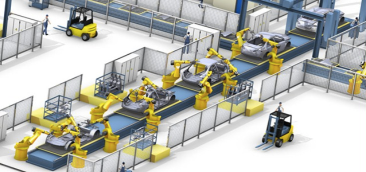
Just to add some fuel my recent post let me pick a topic to elaborate on (hoping I’ll get even more responses on your expectations on the upcoming webinar series).
Today let me focus on “Factory Simulation” (which naturally relates to other topics like “Digital Twin” or “Machine Learning”)
The term “Factory Simulation” is widely used with lots of room for interpretation; and probably most of the interpretations have their own right of existence.
So, a comment I made quite often over the years still stands true: Identify your use case, your business scenario, to put the endeavor into a business context – anything else is useless unless you want to apply technology just for the sake of applying technology.
Most production line managers I talked to really know what they’d like to get out of a factory simulation (vs. a lot of pure IT managers still tend to focus more on the fancy IT stuff), so let’s lean on the production line managers’ interpretations here:
- I need to maintain my level of quality throughout all potential impacts
- I need to maintain or improve my productivity rate
- I need to increase OEE
- I need to deliver on all contracts even if important ad hoc orders come in
Of course the list above is just a small starter, but I guess you get the picture – it’s (as in basically all Industrial IoT scenarios) coming down to making the optimal decision in real time.
Ideally these decisions would be fully automated, but a) a fully automated system will need some time to implement and b) we, as humans, will need some time to gain trust in these automated decisions. So the natural step before full automation is to implement a solution that will simulate scenarios, taking into account all impacting parameters (equipment, material, supply chain, order management….potentially external parameters like weather information), so an experienced line manager can see results for different possible decisions using real world and real time information before making the final decision that will be entered back into MES/ERP/SFM etc for execution.
The number and nature of impacting parameters can range from low and small complexity to high and ultra-complex. In a recent discussion with a customer I was told they’d only need to consider order management, current capacity and throughput rates over pre-production and assembly lines to cover ad hoc orders – not super-easy, but also not too complex. A shop floor worker for another customer told me a few months ago he exactly knows (after operating the equipment for 20+ years) how to tune the equipment in his responsibility to maintain quality with upcoming thunder storms – this example is not so easy to replicate in a simulation, as a lot of additional information and evaluation of this information is required to achieve reasonable results.
I hope this leads to additional thinking and requests – let me have your thoughts, please.
/Chris
